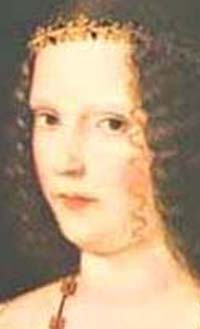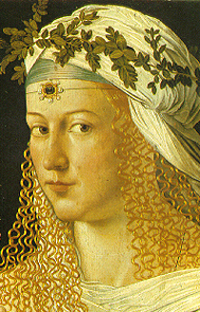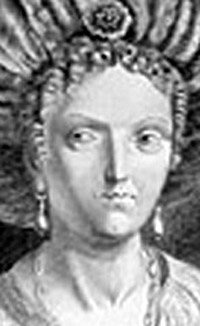Astro-Rayological Interpretation & Charts
Quotes
Biography
Images & Physiognomic Interpretation
A courtier described Lucrezia: "She is of middle height and graceful of form; her face is rather long, as is her nose; her hair is golden, her eyes gray, her mouth rather large, the teeth brilliantly white, her bosom smooth and white and admirably proportioned. Her whole being exudes good humor and gaiety." --- Niccolo Cagnolo (as reported in Cloulas)
1480 - 1519
No single portrait of Lucrezia Borgia captures her contradictory nature more than an allegorical painting by Titian that hangs in the Borghese Gallery in Rome. The painting shows Lucrezia on one edge of a small pool, a naked Venus on the other, and a small cupid between them. The allegory is intended to represent sacred love (Lucrezia) and profane love (Venus). Such is the historical paradox of Lucrezia Borgia.
Lucrezia was the daughter of Cardinal Rodrigo Borgia and his mistress, Vannozza de Cattanei. By the age of eleven, she had been betrothed twice, but both times Rodrigo had rescinded the betrothals. After Rodrigo became Pope Alexander VI, he married her off to Giovanni Sforza, thus establishing an alliance with that powerful Milanese family. The marriage was by proxy, and for four months after her marriage, until the arrival of her new husband in Rome, Lucrezia lived in a handsome palace next to the Vatican with the Pope's new mistress, Guilia Farnese. (Guilia's husband was conveniently away in the Pope's service.) The house was next to the Vatican palace, and Alexander could easily come and go, visiting his daughter and mistress unobserved. A formal wedding ceremony was held shortly after Sforza's arrival, with 500 ladies attending the bride, led by the Pope's mistress. A sumptuous wedding banquet was held, with a work by the ancient Roman playwright Plautus performed, a comedy about libertines, mistresses, and pimps. It was a scandalous event, but not much more opulent than many Renaissance celebrations.After spending two years as the Countess of Pesaro, located in the region where the Pope had sent his son-in-law on a military expedition, Lucrezia returned to Rome with her husband. She served as her father's hostess at diplomatic receptions. Soon, Giovanni Sforza's presence in the papal court meant nothing, since the Borgias no longer needed the Sforzas. New political alliances made the link to the Sforza family no longer of significance to the pope. Lucrezia, informed by her brother Cesare that Giovanni was to be murdered, warned her husband, and he fled Rome. This may have been a ploy on the part of Cesare and Lucrezia to drive her husband away. Lucrezia was delighted to be rid of her boring husband, and Alexander and Cesare even more delighted with the prospect of arranging another profitable marriage for Lucrezia. Of course, they first had to get rid of Giovanni Sforza.
Alexander swung into action. He asked Giovanni's uncle, Cardinal Ascanio Sforza, to get his nephew to agree to a divorce. Giovanni refused, and turned to others in his powerful Milanese family. They, however, were reluctant to quarrel with the Pope, and knowingly suggested the defense of Giovanni's proving his manhood by sleeping with Lucrezia while observed by members of the Borgia and Sforza families. Giovanni rejected the proposal --- as his relatives knew he would --- and counterattacked. He accused Lucrezia of incest with her father and her brothers, Cesare and Giovanni, the Second Duke of Gandia.The Pope used the only valid argument for annulment, the non-consummation of the marriage, and he offered his son-in-law all of his daughter's dowry. The head of the Sforza family threatened to withdraw his protection if his nephew refused the Pope's offer. Giovanni Sforza had no choice, and signed a confession of impotence and the documents of annulment before witnesses.
So much for husband number one. He was actually quite fortunate to escape with his life.
During the bargaining over the divorce, Lucrezia retired to a nearby convent, her only communication with her father during her enforced stay being messages brought by a young chamberlain, Perotto. Six months later, pregnant from a liaison with Perotto, Lucrezia participated in a ceremony in which Vatican judges attested that she was intacta, that is, a virgin. Giovanni Sforza gave sworn testimony to this fact, and the divorce was pronounced "final."
Cesare, discovering his sister's pregnancy, was furious. He made a run at the young Perotto with drawn sword, stabbing him as he knelt before the papal throne, splashing Perotto's blood on his father. Perotto survived the attack, but was thrown into prison. A few days later, Burchard reported that Perotto "had fallen into the Tiber against his will." Six days later, Perotto's body was fished out of the river, along with that of Lucrezia's chambermaid, who, it was believed, had facilitated the affair.
The child from this liaison was born in secret, and, when he was finally recognized, was called the infans Romanus. He was named Giovanni, and is a somewhat mysterious figure in the Borgia history. This child did not surface until three years after his birth, when Alexander declared that he was indeed the infans Romanus, the child of Rome, and was the offspring of Cesare and an unknown woman. This first papal bull was followed by a second, which acknowledged that the child was the son of the pope himself, even though the pope would have been sixty-seven at the time of the child's conception. The purpose of the papal bulls was to give Alexander the excuse to name the young Giovanni the heir to the duchy of Nepi, a property important to the Borgia family. This subterfuge to legitimize the infans Romanus simply led people to assume that the boy was the child of Lucrezia and Alexander, or of Lucrezia and Cesare. The historian Potigliotti suggests that Lucrezia insisted on the two papal bulls because she didn't know which of her two lovers, her father or her brother, had actually fathered the child. Giovanni was passed from guardian to guardian, eventually ending up with Lucrezia in Ferrara as "her half brother." The unfortunate Giovanni never inherited his titles, and, after a lifetime of serving as a minor functionary in the courts of the Vatican and France, died relatively unknown in 1548. The rumor of incest as his origin was begun with Lucrezia's first husband's attack on his former in-laws, and has persisted to this day. It may be true, or it may be that he was the offspring of Lucrezia's indiscretion with Perotto.
Later that year, Lucrezia was married to the seventeen-year-old Prince of Aragon, Alfonso, in Naples, allowing Alexander to forge another alliance with a second important kingdom. Alfonso was the Duke of Bisceglie, an important principality in the Kingdom of Naples. The second wedding feast was as sumptuous as the first, and the two seventeen-year-olds were plainly happy.
As was so often the case at that period of history, political allegiances began to reform, to change, so that ally became adversary. Alfonso, Duke of Bisceglie, suddenly found himself and his family out of favor, as Alexander turned his support to the enemies of Naples. While the Pope assured his son-in-law that he was still in favor --- even giving the young couple a castle, along with the city and lands of Nepi --- Alfonso knew that all was not well. For one thing, Alexander had given the governorship of Spoleto and Foligno, an office usually reserved for cardinals, to Lucrezia, essentially rendering Alfonso as a non-functioning consort. Lucrezia, although only nineteen, was not a mere figurehead, and administered the city well. After a few months, the Pope persuaded his daughter and her husband to return to Rome, to await the birth of the couple's first child, who would be named after her father, Rodrigo.
Not long after, Alfonso, crossing St. Peter's Square, was set upon by a group of armed men. He was seriously wounded and left for dead, but brought into the Vatican apartments to be attended by his wife, Lucrezia. Lucrezia was genuinely distraught, and stayed by her husband's bedside, fully realizing that her brother, Cesare, was behind the attack. Under his wife's tender care, Alfonso almost recovered. Unfortunately, he was visited by his brother-in-law, who ordered Lucrezia, his sister-in-law, Sancia, and the servants out of the room. According to accounts, Cesare ordered his principal henchman to strangle Alfonso. Alexander, seeing his daughter and daughter-in-law fleeing the bedroom in terror, sent his chamberlains to try to prevent the murder. By the time they arrived, it was too late. As Burchard reported, "Since Don Alfonso refused to die of his wounds, he was strangled in his bed."
So much for husband number two. He had not been as fortunate as husband number one.
A year later, while surveying his new acquisitions resulting from the defeat of Alfonso's father, Federigo, King of Naples, Alexander left the administration of the Vatican and the Church in the hands of Lucrezia. A woman of twenty-one, acting as the head of Christendom, did not shock the cardinals of the Curia, accustomed as they were to the excesses of the papacy of Alexander. The Pope was busy amassing money to finance the military adventures of Cesare, and to obtain a grand dowry for Lucrezia, whom he hoped to marry off to a third husband, this time, if possible, to royalty.
Cesare made the selection. The Prince and heir to the duchy of Ferrarra --- a city-state adjacent to Cesare's province of Romagna --- was available. He was twenty-four, and a childless widower. Lucrezia, just twenty-one, would be perfect for him. In return for a huge dowry and the repeal of his papal tax, the Duke of Ferrarra agreed to the marriage. Lucrezia had her third, and final, husband.
Afonso d'Este, the Prince of Ferrara, was a strong silent type, interested in artillery, music and brothels, and was soon captivated by his new wife. From this point on, Lucrezia became a loving wife and admired mother.
Except for a few things. While she pleased her husband and had four children by him, she carried on a romance with the poet Pietro Bembo. Whether it was a physical affair or a platonic romance is not clear, but it temporarily aroused the suspicions of her husband. After Bembo left Ferrara for Venice, his letters to Lucrezia became more formal, and, by 1505, the association was over. Curiously, her relationship with Bembo conferred upon her an artistic sensibility that increased her reputation in Ferrara.
Lucrezia sided with her brother in his various military adventures, and when Cesare died, she was devastated. She set about establishing protection for Rodrigo, her son by her second husband, and "her brother," the mysterious Giovanni, infans Romanus. Against her husband's wishes, she brought them to Ferrara, where they joined the teeming household. Eventually, the two young boys were sent to Isabella of Aragon, who promised to see to their education. Rodrigo died in 1512, at the age of thirteen, and Lucrezia retired in grief to a convent. After a time, she returned to her husband.
After giving birth to her fifth child while in Ferrara, who died shortly after being born, Lucrezia contracted puerperal fever, and died on June 24, 1519. She was not quite thirty-nine years old.
So, Lucrezia, accused of participating in the murders carried out by her father and brother, accused of incest with either her father or brother (or both), died a pious and respected consort of the Duke of Ferrara. One of her sons, Ercole, succeeded his father as Duke, and another, Ippolito, became a cardinal. Both were known for their love of luxury, and, as such, carried on the Borgia tradition of material excess.
Lucretia Borgia was born in April 1480, the daughter of Rodrigo Borgia, who later became pope Alexander VI. She was married, at the age of 13, to Giovanni Sforza from Pesaro and then again, after the annulment of that first wedding, to Alfonso d'Aragona, Duke of Bisceglie when she was 18. Her second husband was murdered two years later by Lucretia's brother, Cesare Borgia, the famous Valentino. Between the two weddings, she embarked on a love affair with Pedro Calderon, a young papal legate. This relationship was dramatically terminated by her family: Pedro was first stabbed and later found dead in the Tiber with his hands and legs tied.
Following new wedding plans of the Borgias, Lucretia was married to Alphonse d'Este, the son of Ercole I, duke of Ferrara, after lengthy negotiations on her dowry. Accompanied by a large cortege, Lucretia left Rome and entered Ferrara on February 2, 1502. She lived in the Este city for seventeen years and her conduct was more subdued than it had been in Rome. Alphonse, asked to meet with her before the marriage, fearing a woman who had provoked so much gossip in her lifetime, a request which was highly unusual for the time. She was a prolific mother (she bore seven children between 1505 and 1519), prudent and patient with the Duke Ercole I-who was always quick to lay claim to her dowry or to cut the expenses of her retinue-and was highly esteemed for her religious devotion, her spiritual retreats and her penitential devotions. During her stay in Ferrara, she established relationships with famous dukes and princes, prominent artists and men of letters of her time, particularly Pietro Bembo, with whom she kept a long and intense correspondence.
Lucretia died in childbirth on June 24, 1519.Cesare's younger sister Lucrezia was supposedly one of the most beautiful women of her time. She was first married in 1493, when she was only thirteen years old, to Giovanni Sforza. This marriage was annulled (cancelled) in 1497. Next, only a year later, she married Alfonso, Duke of Bisceglie. He was the husband Cesare is thought to have had killed.
There was much talk of scandal at this time. Lucrezia's first husband had rumoured that the Borgias were an incestuous family. It was also known that Lucrezia had attended orgies in the Vatican. In any case, Lucrezia "disappeared" for the public eye for a while and in 1501 she was seen with a small child. This young boy was first claimed as the son of Cesare and later as Pope Alexandre's son. Her third marriage was to Alfonso d'Este. Lucrezia went to the court of Ferrara with her husband. All of her marriages had been arranged for political reasons. She was only freed from being used as a political pawn when her father died. She lived quietly during the last few years of her life and became very religious. She was thirty nine when she died.
Lucrezia Borgia






